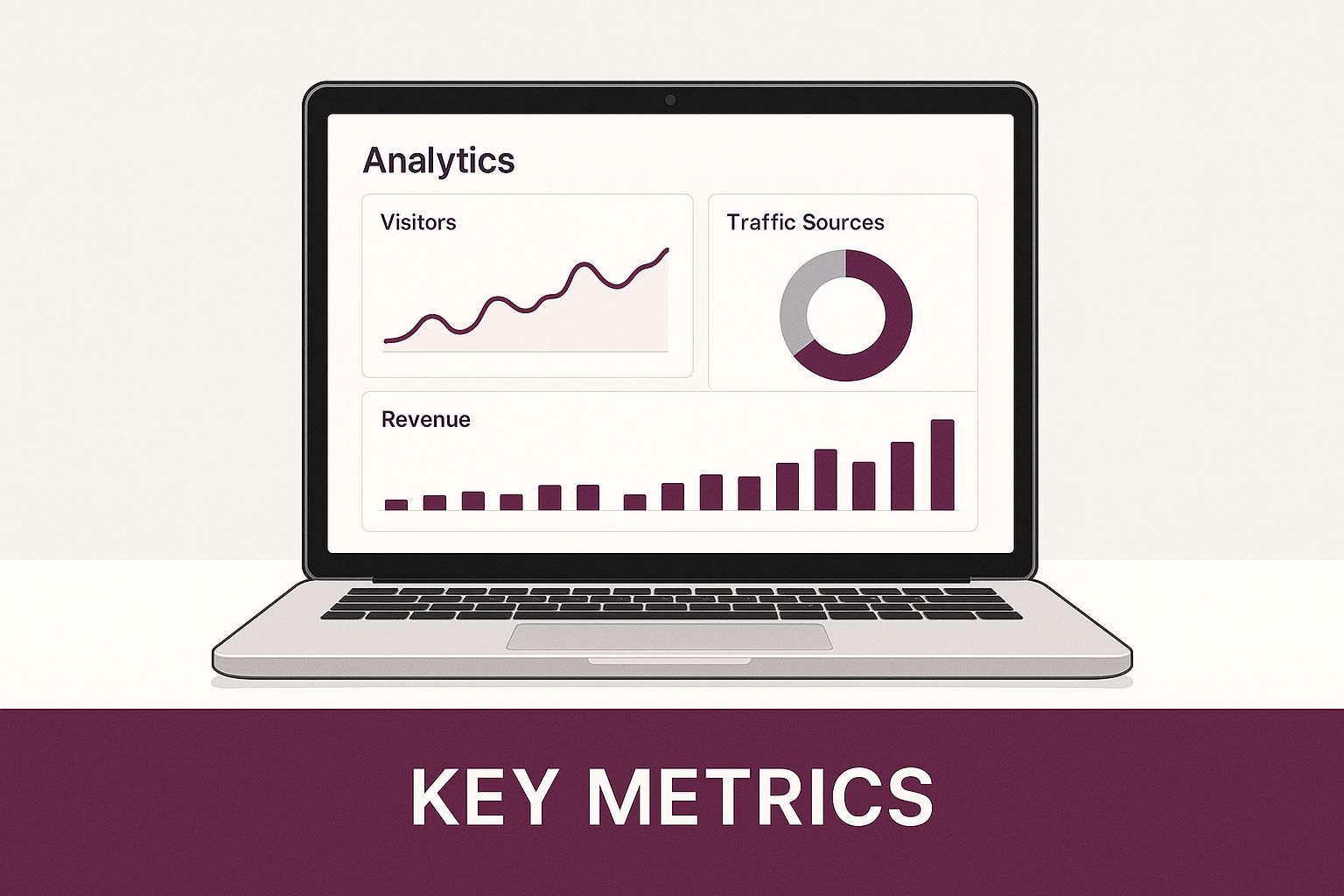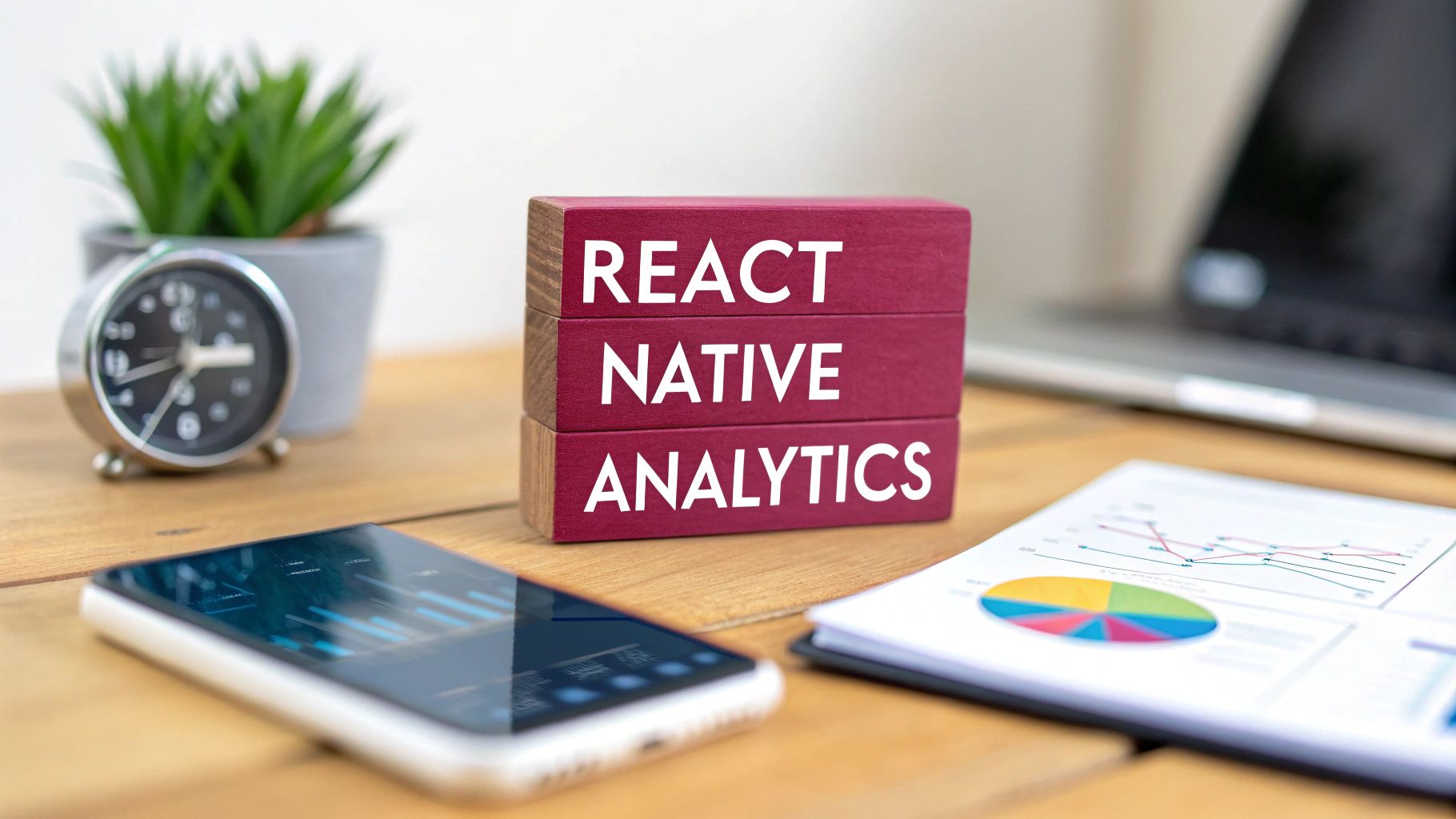Understanding Real-Time App Analytics Beyond The Hype
Let’s face it, the term “real-time” gets used quite liberally in the tech world. But when it comes to your mobile app, what does real-time app analytics truly deliver? Imagine it like this: real-time analytics is the air traffic control tower for your app. You get to see every user interaction, every crash, and every conversion the moment it occurs—not hours or days later. Trying to guide a plane with last week’s weather report wouldn’t be very effective, would it? That’s the power of real-time information.
This shift from reacting to problems after they’ve happened to proactively optimizing your app before they arise is crucial. In the fast-paced world of mobile apps, milliseconds can make all the difference. A minor lag in loading time could be the deciding factor between a user engaging with your app or uninstalling it in frustration. These instant feedback loops are the secret sauce that separates thriving apps from those that disappear without a trace.
For instance, picture a critical bug suddenly appearing during a major promotional campaign. With real-time app analytics, you can pinpoint the problem and deploy a fix within minutes, potentially saving your campaign and preventing a mass exodus of users.
Real-time data also allows for continuous improvement. It reveals how users navigate new features, identifies sticking points in the onboarding process, and highlights which promotions are truly converting. Armed with these insights, you can fine-tune your app’s design, messaging, and even your overall marketing approach in real-time, maximizing user engagement and boosting revenue. This focus on real-time data is a trend reflected in the broader analytics market, which includes real-time app analytics. By 2023, this market was estimated to be worth around USD 25 billion, demonstrating the growing need for immediate data processing and analysis across various industries. Learn more about real-time analytics growth
Real-time app analytics isn’t simply about impressive dashboards. It’s about cultivating a culture of data-driven decision-making within your team. It empowers them to move with greater agility, iterate more effectively, and ultimately, craft a better product that resonates with users. This naturally leads us to explore why this approach to analytics is particularly essential for mobile.
Why Mobile Changed Everything For App Analytics

Mobile devices have drastically changed how we interact with technology. We’re now accustomed to instant information and seamless experiences. Think about it: desktop users might tolerate a website taking a few extra seconds to load, but mobile users? Not so much. They expect apps to be quick, intuitive, and deliver value immediately.
This shift in user expectations has made real-time app analytics essential. It’s no longer a nice-to-have, but a need-to-have for app developers.
Let’s say a retail app crashes during a flash sale. Every second the app is down means lost sales and unhappy customers. Traditional analytics reports, generated weekly or monthly, would eventually reveal what went wrong, but it would be too late. The damage would already be done.
Real-time app analytics, however, provides immediate alerts. Imagine a flashing red light on a dashboard, signaling the crash. Developers can jump in, figure out the problem, and fix it quickly, minimizing disruptions and keeping customers happy.
This need for immediate feedback is fueled by the always-on nature of mobile. We use apps throughout the day, at home, at work, on the go. This constant interaction creates a dynamic and complex usage pattern that requires continuous monitoring. And the app analytics market is booming because of this. In 2023, the market was valued at USD 6.3 billion, and is projected to reach USD 6.27 billion by 2025. Discover more insights into the app analytics market
The mobile world is also incredibly competitive. Thousands of apps compete for our attention. To succeed, you need to understand user behavior instantly and adapt your strategies. Real-time analytics allows app teams to track key metrics like user engagement, conversion rates, and crash reports, giving them the flexibility to respond to trends and optimize the user experience. For those working with React Native, understanding the nuances of analytics is particularly important - you might be interested in: analytics for React Native. In essence, real-time analytics helps you understand what your mobile audience wants right now and build an app that truly meets their needs in the moment.
Essential Metrics That Actually Drive Mobile Success
Not all metrics are created equal. Some offer valuable insights into user behavior and app performance, while others just add noise. Think of it like a car dashboard: the speedometer and fuel gauge are essential, while the clock and radio station display are less critical for driving. This section explores the key performance indicators (KPIs) that truly matter for mobile success, focusing on how real-time app analytics empowers you to use this data effectively. We’ll also distinguish between leading indicators, which give you a glimpse into the future (like daily active users), and lagging indicators, which confirm what’s already happened (like monthly revenue).

The infographic above showcases how a sleek analytics dashboard visualizes key metrics, delivering their real-time values at a glance. This immediate visibility is like having a live feed from your app, letting you spot trends and react quickly. By monitoring leading indicators like active users and session duration in real time, app developers can anticipate potential problems and proactively optimize the user experience before they escalate into major issues.
Real-Time Insights: A Practical Example
Imagine a sudden dip in average session duration. This could indicate a problem with a new feature, a buggy update, or confusing navigation. Real-time app analytics acts like an early warning system, alerting you to the issue immediately. This allows for rapid intervention, preventing widespread user frustration. Contrast this with traditional analytics, where such a problem might only be discovered weeks later—like noticing a slow leak in your tire only after it’s gone flat. You might be interested in: Check out our guide on app engagement metrics.
Understanding which engagement signals correlate with long-term retention is also critical. For instance, high daily active users combined with increasing session lengths often indicate that users are finding genuine value in your app—they’re not just popping in and out, they’re sticking around and exploring.
Avoiding Metric Overload
However, just as a cluttered dashboard can distract a driver, it’s important to avoid metric fatigue by focusing on a select set of truly impactful KPIs. This means having a clear strategy for your analytics implementation. Define your specific business goals first. Then identify the metrics that directly contribute to reaching those goals. Prioritizing these essential metrics keeps you focused on what truly drives business outcomes and user satisfaction.
To help you navigate this, let’s look at a comparison of some essential real-time app metrics. The following table outlines their importance, typical benchmarks, and the actions you might take based on their real-time behavior.
Essential Real-Time App Metrics Comparison: This table provides a quick comparison of key real-time metrics, showing their importance, typical benchmarks, and when you should take action.
| Metric | Importance Level | Typical Benchmark | Action Trigger | Response Time |
|---|---|---|---|---|
| Daily Active Users (DAU) | High | Varies by app category | Significant drop or unexpected spike | Within hours |
| Average Session Duration | High | Varies by app type | Sudden drop or significant increase | Within a day |
| Crash Rate | Critical | < 2% | Spike in crashes | Immediately |
| Network Latency | High | < 500ms | Consistent increase or spikes | Within a day |
| User Retention Rate (Day 1, 7, 30) | High | Varies, aim for consistent improvement | Drop in retention | Investigate trends |
| In-App Purchases | High (for monetized apps) | Varies by app and pricing | Significant drop or unexpected spike | Within a day |
By understanding these metrics and their typical behaviors, you can gain valuable real-time insights into your app’s performance and make informed decisions. Remember, the goal isn’t just to collect data; it’s to use that data to improve the user experience and drive success.
Real Success Stories From Mobile Teams In The Trenches
We’ve talked theory, but sometimes seeing how something works in the real world makes it click. So, let’s explore how mobile development teams are using real-time app analytics to achieve their goals and steer clear of trouble.
Preventing a Fitness App Fail
Picture this: a popular fitness app is hosting a big virtual workout. Thousands of users log in, ready to sweat. Suddenly, the app crashes. Without real-time crash monitoring, this could have been a disaster, leading to tons of uninstalls and a PR nightmare.
But this team was smart. They had real-time app analytics in place. They got instant alerts showing a major bug triggered by the sudden influx of users. Think of it like a fire alarm going off, telling them exactly where the fire is.
Within minutes, they pinpointed the problem, pushed out a fix, and saved the event. This quick action stopped thousands of frustrated users from giving up on the app.
Optimizing an E-Commerce Checkout
An e-commerce team noticed shoppers were abandoning their carts a lot. Traditional analytics would have shown them this eventually, but this team was using real-time data. They could actually watch user behavior during checkout.
It was like having a hidden camera in a store. They saw users getting stuck at a particular form field. It was confusing! By simplifying the form, based on these real-time observations, they boosted conversions by a whopping 34% in just a few hours. This is a perfect example of how quick feedback can lead to fast and effective changes. Interested in learning more about successful updates? Check out our guide on: mobile app update strategy.
Rescuing Engagement on a Social Media App
A social media app saw a sudden drop in user engagement – like a party suddenly going quiet. Real-time app analytics showed fewer post interactions and shares. By digging into the real-time data, the team realized a recent algorithm tweak was accidentally hiding popular content.
They quickly adjusted the algorithm, bringing back the buzz before they lost a significant number of users. This proactive move prevented a potential disaster and kept users engaged.
These aren’t just stories; they’re lessons. They show how real-time app analytics lets mobile teams be proactive, not reactive. They emphasize the value of having instant insights into your app’s performance.
By learning from these examples, you can apply similar strategies to tackle your own app’s challenges and unlock growth opportunities, no matter the app’s category or audience size. Each story highlights the power of using data to make smart, quick decisions in the fast-moving world of mobile apps.
Choosing Your Real-Time Analytics Platform Strategically

Picking the right real-time app analytics platform can feel like navigating a maze. So many options, so many promises. This section helps you cut through the noise and find the platform that truly fits your needs. Because just like any important decision, choosing an analytics platform isn’t one-size-fits-all. It needs to align with your specific goals, tech setup, and team’s abilities.
Key Considerations: Beyond the Buzz
Choosing the right analytics platform isn’t about ticking boxes on a feature list. It’s about understanding which features truly matter for your app. Imagine buying a car – you wouldn’t just pick the one with the flashiest paint job, right? You’d think about how it handles, its fuel economy, and whether it fits your lifestyle.
Similarly, with real-time app analytics, consider data processing speed. How quickly can the platform crunch your data and give you actionable insights? This speed directly affects how fast you can react to changes in user behavior or app performance. Integration complexity is also key. Will the platform play nicely with your existing tech stack, or will it require a major overhaul? A complicated integration can drain time and resources.
Don’t get caught off guard by hidden costs, either. Some platforms have unexpected fees for things like data storage, user licenses, or going over usage limits. And finally, think about scalability. Can the platform handle your app’s growth, or will it become a bottleneck down the road? Choosing a platform that can’t scale is like buying shoes a size too small – uncomfortable and limiting.
A Systematic Approach to Selection
Before diving into the platform options, take stock of your current tech setup. What development framework are you using? What’s your data infrastructure like? Do you already use other analytics tools? Understanding your existing environment is crucial for choosing a platform that fits seamlessly.
Next, separate the must-have features from the nice-to-haves. Do you really need all those bells and whistles, or will they just add complexity? Focus on features that directly address your business goals and user needs. While a powerful analytics platform is essential, a solid deployment rollback plan is equally important. A well-defined rollback plan can save you from costly downtime and headaches. You might be interested in: Check out our guide on deployment rollback plans. Also, consider the potential pain of platform migrations. Switching platforms can disrupt your workflow and eat up valuable resources. Plan carefully to avoid unnecessary switching costs.
Finding the Right Fit
Different apps have different needs. A gaming app might prioritize real-time latency tracking, while an e-commerce app might focus on conversion funnels. Do your research and find out which platforms excel in your specific area. Consider platforms like Firebase, Mixpanel, and Amplitude.
Finally, get your team on board. Show them how real-time app analytics can translate into tangible business benefits, like improved user retention, increased revenue, or reduced development costs. This helps justify the investment and ensures everyone is working towards the same goals.
To help you compare some of the popular options, take a look at the table below:
Real-Time Analytics Platform Comparison: Side-by-side comparison of popular real-time analytics platforms showing features, pricing, and integration complexity.
| Platform | Key Features | Pricing Model | Integration Difficulty | Best For |
|---|---|---|---|---|
| Firebase | Real-time database, crash reporting, user analytics | Usage-based, free tier available | Easy | Mobile apps, startups |
| Mixpanel | User behavior tracking, A/B testing, engagement analysis | Usage-based, free trial available | Medium | SaaS products, mobile apps |
| Amplitude | Product analytics, user segmentation, cohort analysis | Usage-based, free trial available | Medium | Product-led growth companies |
| CodePushGo | Deployment rollback, feature flags, real-time monitoring | Contact for pricing | Easy | Mobile apps, React Native apps |
This table summarizes the key features, pricing, and integration complexity of each platform, allowing for quick comparison. Remember to explore each platform in detail to understand its full capabilities.
By taking a strategic, thoughtful approach, you can choose a real-time app analytics platform that empowers your team, delivers valuable insights, and helps your app thrive.
From Installation To Actionable Insights That Matter
Having the right real-time app analytics platform is like having a top-notch chef’s knife. It’s a powerful tool, but its effectiveness depends entirely on the skill of the user. This section explores how to wield your chosen platform effectively, transforming raw data into valuable insights that drive real business decisions. We’ll cover the journey from defining your measurement strategy to building workflows that ensure those insights translate into tangible improvements.
Defining Your Measurement Strategy
Before diving into implementation, let’s pause and define our objectives. Think of it like charting a course for a sailing expedition. You wouldn’t leave port without knowing your destination, would you? Similarly, you need a clear understanding of your app’s key business goals. Are you aiming to increase user engagement, boost in-app purchases, or minimize churn?
Your analytics implementation should directly support these goals. Once you’ve identified them, you can select the Key Performance Indicators (KPIs) that will measure your progress. Focus on the metrics that genuinely matter, like a seasoned navigator relying on the most critical navigational instruments. This prevents metric fatigue and keeps your team focused on what truly drives results.
Setting Up Tracking and Alerts
With your KPIs defined, it’s time to configure your analytics platform to track them. This involves integrating the platform’s Software Development Kit (SDK) into your app and setting up event tracking for user interactions, crashes, and other important events. Imagine these events as signals being transmitted from your app, providing valuable information about its performance.
For further guidance on setting up efficient performance tracking, check out best practices for Application Performance Monitoring. It’s a valuable resource for understanding the nuances of performance measurement. You might be interested in: Learn more in our article about application performance monitoring best practices.
The next step is establishing an alert system. Real-time alerts act as an early warning system, notifying you of critical issues as they arise. Think of them as the canaries in a coal mine, alerting you to potential dangers. However, avoid setting up too many alerts, as this can lead to alert fatigue, just like an oversensitive car alarm eventually being ignored. Prioritize alerts for events that demand immediate action, like a sudden surge in crashes or a noticeable drop in user engagement.
Building a Data-Driven Culture
Implementing a real-time analytics platform is more than just about technology; it’s about fostering a data-driven culture within your team. This means empowering your team to interpret real-time data effectively and make informed decisions based on those insights. Think of it as providing your team with the skills and tools of a master craftsman, enabling them to create something truly exceptional.
Establish clear workflows that link insights to action. For example, if real-time data reveals a problem with a new feature, have a process in place for quickly prioritizing and addressing the issue. This ensures that insights translate into tangible improvements and don’t just remain static figures on a dashboard. The integration of real-time app analytics with emerging technologies, such as AI and IoT, further enhances this process, providing even deeper insights into user behavior and enabling more effective optimization. Discover more insights.
Finally, it’s important to measure the return on investment (ROI) of your analytics implementation. Track how real-time insights have contributed to achieving your business goals. This data justifies the investment in analytics and demonstrates its value to stakeholders. By following these steps, you can transform your real-time app analytics platform from a passive data collector into a dynamic engine for growth and continuous improvement.
Your Mobile Analytics Success Roadmap
Imagine real-time app analytics not as just a flashy dashboard, but as a powerful lens through which you can observe the inner workings of your mobile app. This section acts as your roadmap to implementing analytics that don’t just collect data, but actually drive tangible improvements. We’ll walk through practical first steps, achievable short-term goals, and how to measure the long-term impact of your analytics investment.
Taking Action: First Steps
Before diving into the technical details, it’s crucial to take a step back and define your core business objectives. What are you ultimately hoping to achieve? Are you aiming to boost user engagement, increase conversion rates, or perhaps minimize user churn? Your analytics strategy should be directly aligned with these fundamental goals.
Once you’ve identified your objectives, the next step is to choose the Key Performance Indicators (KPIs) that best reflect them. Don’t get caught in the trap of tracking every single metric under the sun. Instead, focus on the vital few that truly matter, such as daily active users, session duration, and conversion rates.
Building Momentum: Short-Term Wins
With your KPIs clearly defined, you’re ready to implement your chosen analytics platform and begin tracking. Aim for early victories by tackling the low-hanging fruit. For example, if real-time data reveals a high abandonment rate on a particular screen, investigate the user experience on that screen and optimize it. You should be able to see positive changes within a matter of days or weeks.
Parallel to this, start fostering a data-driven culture within your team. Train your team members to interpret real-time data and translate those insights into actionable improvements. This involves creating clear procedures for responding to critical alerts and prioritizing improvements based on the data collected.
Sustaining Success: Long-Term Strategies
As your team becomes more comfortable with real-time analytics, you can begin to explore more nuanced areas like user segmentation and personalized experiences. For instance, use the real-time data to identify distinct user groups and tailor your in-app messaging and offers to their specific needs. This level of personalization requires a deeper understanding of user behavior and more sophisticated analytics tools. Expect to see results from these initiatives unfold over several months.
Don’t forget to regularly review your analytics strategy and adjust your KPIs as your app evolves. The mobile landscape is dynamic, and your analytics approach needs to adapt accordingly. This continuous refinement ensures that your analytics investment continues to provide valuable insights over the long term.
Measuring Impact and ROI
Throughout this process, it’s important to track the effect of your analytics initiatives on your core business objectives. Are you seeing a rise in user engagement? Have conversion rates improved? Has user churn decreased? Quantify these improvements and calculate the Return on Investment (ROI) of your analytics efforts. This data not only demonstrates the value of your efforts to stakeholders, but also justifies continued investment in real-time analytics.
By following this roadmap, you’ll avoid the common pitfall of collecting impressive data without actually putting it to use. You’ll build sustainable practices for using real-time insights to fuel your long-term mobile success. Ready to take your React Native app to the next level with real-time insights and over-the-air updates? Explore what CodePushGo has to offer and transform how you build, optimize, and grow your mobile application. Visit CodePushGo now!




